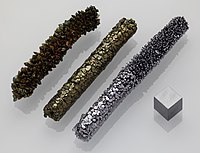
Photo from wikipedia
Magnetic nanoparticles (MNPs) present outstanding properties making them suitable as therapeutic agents for hyperthermia treatments. Since the main safety concerns of MNPs are represented by their inherent instability in a… Click to show full abstract
Magnetic nanoparticles (MNPs) present outstanding properties making them suitable as therapeutic agents for hyperthermia treatments. Since the main safety concerns of MNPs are represented by their inherent instability in a biological medium, strategies to both achieve long-term stability and monitor hazardous MNP degradation are needed. We combined a dynamic approach relying on flow field flow fractionation (FFF)-multidetection with conventional techniques to explore frame-by-frame changes of MNPs injected in simulated biological medium, hypothesize the interaction mechanism they are subject to when surrounded by a saline, protein-rich environment, and understand their behaviour at the most critical point of intravenous administration. In the first moments of MNPs administration in the patient, MNPs change their surrounding from a favorable to an unfavorable medium, i.e., a complex biological fluid such as blood; the particles evolve from a synthetic identity to a biological identity, a transition that needs to be carefully monitored. The dynamic approach presented herein represents an optimal alternative to conventional batch techniques that can monitor only size, shape, surface charge, and aggregation phenomena as an averaged information, given that they cannot resolve different populations present in the sample and cannot give accurate information about the evolution or temporary instability of MNPs. The designed FFF method equipped with a multidetection system enabled the separation of the particle populations providing selective information on their morphological evolution and on nanoparticle–proteins interaction in the very first steps of infusion. Results showed that in a dynamic biological setting and following interaction with serum albumin, PP-MNPs retain their colloidal properties, supporting their safety profile for intravenous administration.
Journal Title: Pharmaceutics
Year Published: 2022
Link to full text (if available)
Share on Social Media: Sign Up to like & get
recommendations!